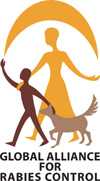Global Alliance for Rabies Control

The Global Alliance for Rabies Control is a non-profit organization that aims to increase awareness of the continuing threat of rabies around the world. It promotes education about rabies, supports rabies control projects to demonstrate how the impact of this disease can be lessened, and advocates at an international level for increased resources for rabies prevention and control.
Organization and Aims
The Global Alliance for Rabies Control,[1] has two branches: The Alliance for Rabies Control, established in Scotland in 2006 (registered charity No. SC 037712); and the headquarters of the organization, The Global Alliance for Rabies Control, established in 2007 in the USA (a 501c3 organization).
It is dedicated to eliminating rabies in both humans and animals. The Alliance brings together partners involved in rabies prevention and control to address rabies in the areas of the world where it is endemic or where people and animals are most at risk. The group’s mission[2] is to prevent human rabies deaths, and to alleviate the burden of rabies in animal species. It acts as a coordinator for its global community of advocates, providing information and educational resources which allow them to take action in their own communities.
The Alliance’s patron is the author Alexander McCall Smith[3] who recently produced a film[4] on their behalf during a visit to a rabies control project in Tanzania.
How the Global Alliance for Rabies Control works
The Alliance works in partnership with anyone who has in interest in rabies control: international organizations, e.g. the Pan American Health Organization;[5] national and local organizations; industrial partners; and a large network of individual volunteers. It manages an international campaign, World Rabies Day, which has been endorsed by all leading international health and veterinary organizations including the World Health Organization,[6] and the World Veterinary Association.[7]
The Alliance actively promotes rabies education across the world, hosting an education bank [8] of resources such as school lesson plans, posters and leaflets for various audiences, in several languages.
It has supported several small community based rabies education projects,[9] and managed larger scale rabies elimination projects, such as one on the island of Bohol, which recently resulted in the elimination of canine rabies on the island,[10] and an adopt-a-village project in India.[11]
The Bohol project was awarded the Galing Pook in 2011 [12] and The Charity Award 2013 for Healthcare and Medical Research. [13]
Partners for Rabies Prevention
In 2008, the Alliance created the Partners for Rabies Prevention, an informal group of cross-agency rabies experts. Partners include international organizations such as the World Health Organization (WHO), World Organisation for Animal Health (OIE), the Food and Agriculture Organization of the United Nations (FAO), the Centres for Disease Control and Prevention in Atlanta, USA (CDC) and pharmaceutical industry partners. The Alliance acts as the secretariat for this informal group.
The Partners for Rabies Prevention recently developed and launched the Blueprint for Rabies Control,[14] a freely available practical guide to controlling canine rabies in endemic countries. This project involved extensive collaboration[15] to gather all relevant existing guidelines, best practices and case studies into a single website. It involves material on roles and responsibilities, infrastructure, legislative framework, costs and funding, communications planning and operational activities, and was formulated as a comprehensive step-by-step guide to help organizations and governments implement rabies control practices in canine rabies endemic areas.
See also
References
- ↑ Global Alliance for Rabies Control , accessed November 16th, 2010.
- ↑ Global Alliance for Rabies Control Website , accessed November 16th, 2010.
- ↑ Alexander McCall Smith , accessed November 16th, 2010.
- ↑ Alexander McCall Smith , accessed November 16th, 2010.
- ↑ Pan American Health Organization , accessed November 23rd, 2010.
- ↑ World Health Organization , accessed November 16th, 2010.
- ↑ World Veterinary Association http://www.worldvet.org/taxonomy/term/20, accessed November 16th, 2010.
- ↑ Global Alliance for Rabies Control , accessed August 14th, 2013.
- ↑ Global Alliance for Rabies Control , accessed November 16th, 2010.
- ↑ Bohol News Chronicle , accessed November 16th, 2010.
- ↑ Schering-Plough , accessed November 23rd, 2010.
- ↑ The Bohol Chronicle , accessed August 14th, 2013.
- ↑ The Civil Society , accessed August 14th, 2013.
- ↑ Blueprint for Rabies Control , accessed November 16th, 2010.
- ↑ Blueprint for Rabies Control , accessed November 16th, 2010.